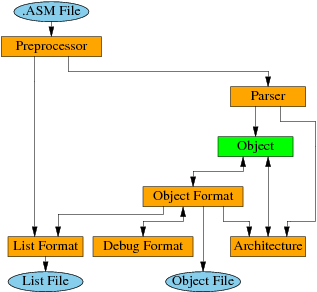Yasm is conceptually divided into a number of separable modules.
Assuming that the programmatic interface of each module is well-defined, it is easy to customize the different parts of the assembler. Contributors can write new parsers, new preprocessors, new optimizers, and new object formats. Multiple types of each module may be simultaneously compiled in and are user-selectable at runtime via command-line or other configuration methods.
Figure 2.1 illustrates the 3-stage pipeline architecture of the assembler, and where each particular interface fits between the pipeline stages. The data passed between each stage is structured as a linked list of bytecodes (an internal representation of a machine instruction or assembler pseudo-instruction, see Section 3.1 for more information). Two additional stages are shown in Figure 2.1, the preprocessor and the debug format, which while being major components of the overall architecture, execute in parallel with a main pipeline stage.
However, yasm isn’t a pipeline in the traditional computer architecture sense of the word, as none of the stages execute in parallel.
In addition to the main pipeline shown in Figure 2.1, a number of additional modules are necessary in order to have a fully functional assembler. Some of these modules are called from multiple stages and thus must be able to function under many different conditions. Figure 2.2 shows how the pipeline interfaces with these additional modules to create a complete assembler.
A variety of support modules provide basic data structures and I/O functions. Many of these modules are called or used in some fashion by nearly every module shown in Figure 2.2. Figure 2.3 shows the relationships between these support modules.
Figure 2.4 shows an example of a built-out assembler with multiple preprocessors, parsers, object formats, etc, and how all the pieces fit together.



